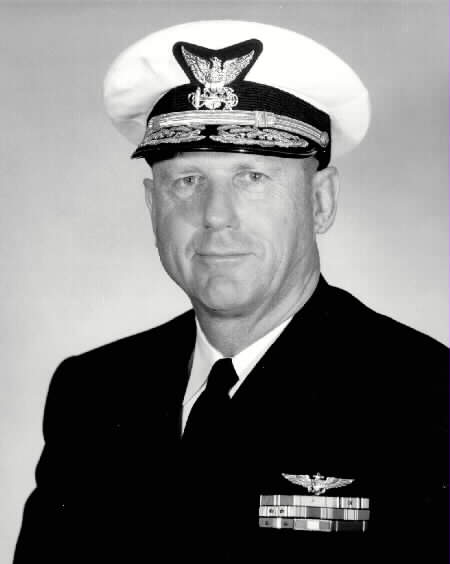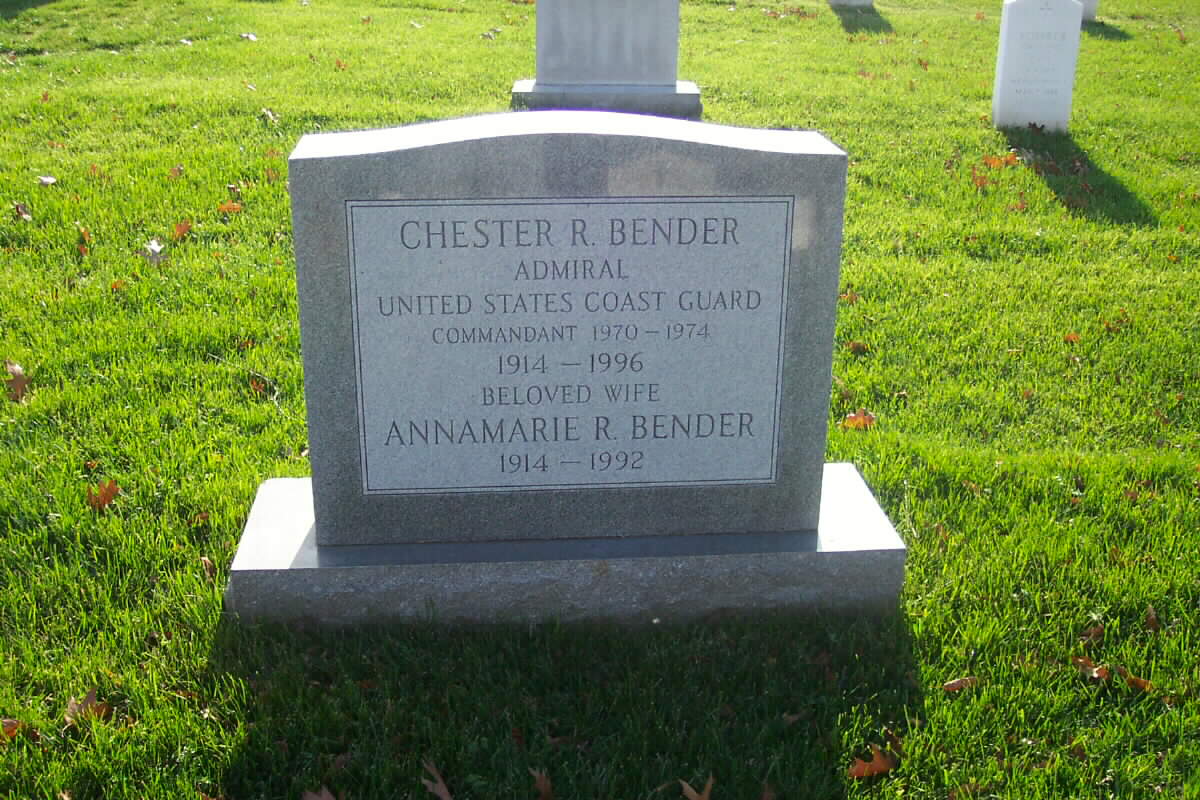Contemporary Press Report:
Admiral Chester R. Bender, former Commandant of the Coast Guard (1970-1974), and the man most remembered by the Coast Guard for adopting its distinctive “Bender Blues” uniform, passed away July 20, 1996, in Moraga, California following a long illness. He was 82. Admiral Bender is survived by his son, Mark A. Bender, of Lafayette, California, several nieces and nephews, and a sister-in-law. Funeral services were held August 7, 1996 at Arlington National Cemetery, Arlington, Virginia with full military honors. He is buried there next to his wife, the former Annamarie (Mollie) Ransom, who died in 1992.
What follows are biographical excerpts about ADM Bender from an article by Judy Thiede Wade published in The Courier, Plant City, Fla. newspaper earlier this year, prior to his passing.
Admiral Chester R. Bender, who served as the Coast Guard’s 14th Commandant (1970-1974), always believed in giving back to his community and wanted to give the people of his hometown of Plant City, Florida something to remember him by. Just prior to his death, he donated several of his military artifacts to the East Hillsborough Historical Society for display at the high school. The items are temporarily housed in a display case at the Plant City City Hall.
“Since my primary interest in preserving history is through family history, I’m extremely proud for the Bender family to be able to bring Admiral Bender’s Coast Guard history back to his hometown of Plant City,” said Shelby Bender, wife of Admiral Bender’s great-nephew, Andy.
Born March 19, 1914 in Burnsville, West Virginia., Bender’s family moved to Plant City in 1925. He graduated from Plant City High School and entered the Coast Guard Academy in 1932. In 1936, he became the first Floridian to graduate from the Academy, earning a bachelor of science degree and commission as ensign. He spent his initial duty time as a line officer aboard several cutters and eventually earned his aviator wings. Then-Lieutenant Commander Bender served as commander of an air-sea rescue squadron from June 1943 to December 1944. After being promoted to rear admiral in 1964, he was assigned as Superintendent of the Coast Guard Academy the following year. In 1970, he was nominated by President Richard Nixon to serve as Commandant.
Admiral Bender’s awards included the Bronze Star, Legion of Merit, and two Distinguished Service Medals. But he is perhaps most proud of and best remembered today for his creation of the “Bender Blues” Coast Guard uniform. Shortly after taking over as Commandant, he formed a board of officers to design a new, universal formal uniform that would distinguish Coast Guard officers from Navy officers. Before the change, Coast Guard uniforms consisted of a white shirt, black tie and a black, double-breasted jacket and were a modification of Navy attire. Bender cited two main reasons for pushing for the change. First, he wanted to create a distinctly different look from that of the Navy. In doing so, he wanted to solidify the fact that the Coast Guard was a separate organization. Secondly, he wanted the new uniform to be more contemporary in style. The redesigned uniform is still worn by Coast Guardsmen today.
Courtesy of the United States Coast Guard
Chester R. Bender was born March 19, 1914, at Burnsville, WV, the son of John I. and Inez (Harbert) Bender. He received elementary and high school education in Burnsville and Plant City, FL, where he moved with his family in 1925.
He was appointed a cadet and entered the Coast Guard Academy in New London, CT in 1932. He was a member of the Academy boxing squad for two years. During his first class (senior) year, he was gun captain and served as humor editor of “Tide Rips”, the cadet yearbook. On June 8, 1936, he became the first Floridian to graduate from the Coast Guard Academy when he received his Bachelor of Science degree and commission as Ensign.
Ensign Bender’s initial duty was as a line officer aboard the cutters MENDOTA and BIBB, both on Atlantic patrol. In 1938, he was transferred to the cutter OSSIPEE, operating in the Great Lakes. During this tour he met his future bride, Annamarie Ranson of Sault Ste. Marie, MI. They were married September 1, 1939.
He was selected for flight training in 1939, and in June of that year began training at the U.S. Naval Air Station at Pensacola, Fla. A year later he received his aviator’s wings and was assigned to flight duty at the Coast Guard Air Station at Elizabeth City, N.C. With the start of World War II, Lieutenant Bender flew anti-submarine patrols out of Elizabeth City.
Lieutenant Commander Bender served as commander of an air-sea rescue squadron at the Coast Guard Air Station at San Diego, CA, from June 1943 to December 1944. He was promoted to the rank of Commander halfway through that tour of duty. Commander Bender then served as air-sea rescue advisor and liaison officer with the Far East Air Force Headquarters in the Philippines for the remainder of the war. He was awarded the Bronze Star Medal for this service.
In December 1945, he was assigned to Coast Guard Headquarters, Washington, DC as executive officer of the Air-Sea Rescue Agency. The following September he became pilot and personal aide to the Commandant of the Coast Guard. In June 1950, Commander Bender became executive officer of the Coast Guard Air Station at St. Petersburg, FL. Three years later he vent to Traverse City, MI to command the air station there.
He returned to Headquarters in June 1955 to head the War Plans Division. He was promoted to Captain in 1958 and assumed command of the Coast Guard Air Detachment at Barbers Point, HI. The following year, after 20 years in aviation, he returned to sea in command of the 311-foot cutter BERING STRAIT, operating on ocean station duty out of Honolulu.
In July 1961, he began a one-year assignment as mobilization and readiness officer on the staff of the Western Area Commander in San Francisco, Calif. He then returned to Washington, DC as Chief of the Administrative Management Division and later Chief of the Program Analysis Division at Coast Guard Headquarters.
In January 1964, President Lyndon Johnson nominated Captain Bender for flag rank and on July 1 of that year, he was promoted to Rear Admiral. At that time, he took command of the Ninth Coast Guard District headquartered in Cleveland, OH. A year later he was assigned as Superintendent of the Coast Guard Academy, relieving Rear Admiral Willard J. Smith, who later became Commandant of the Coast Guard.
During his two years as Superintendent, Admiral Bender continued the Academy’s major construction program with Roland Hall Field house, one of the East Coast’s most complete and modern athletic facilities nearly completed during his tour. He also established the U.S. Coast Guard Museum at the Academy, to preserve and display artifacts of the early Coast Guard.
In June 1967, he assumed command of the Twelfth Coast Guard District and Coast Guard Western Area, with offices in San Francisco, CA. In the former position, he had responsibility for all Coast Guard units in Northern California and most of Utah and Nevada as well as areas In the Pacific. In the other assignment, he was the senior Coast Guard officer in the Pacific and exercised certain operational controls over Coast Guard
commands throughout that ocean.
On April 16, 1970, President Richard M. Nixon nominated Chester R. Bender to be Commandant of the Coast Guard with the four-star rank of Admiral. The Senate confirmed the nomination on April 30. Admiral Bender relieved Admiral Willard J. Smith as Commandant on June 1, 1970.
Admiral Bender retired as Commandant effective June 1, 1974 after being relieved by Admiral Owen W. Siler, USCG at formal change-of-command ceremonies held at the Washington Navy Yard May 31, 1974 The cutters USCGC EAGLE and USCGC INGHAM were brought in to participate. Admiral Bender died on July 20, 1996 in Moraga, CA following a long illness.
As Commandant, Admiral Bender implemented significant legislation that still stands. At his retirement ceremony, he was lauded for outstanding contributions to the control of marine pollution in his role as delegate and alternate chairman of the U. S. Delegation to the Marine Pollution Conference of IMCO in 1973. He was also cited for management of sensitive programs as the Coast Guard undertook new statutory responsibilities in the areas of marine safety, environmental protection and law enforcement. Admiral Bender, however, is best remembered for having established a distinctive uniform for the Coast Guard, still known as the “Bender Blues.”
AWARDS:
In addition to the Bronze Star Medal, Admiral Bender’s World War II campaign service medals and ribbons include: American Area; American Defense; Asiatic- Pacific with two bronze stars (ribbon) for participation in the Southern Philippine and Luzon campaigns; Philippine Liberation with two bronze stars; Philippine Presidential Unit Citation; World War II Victory Medal.
Other awards include the National Defense Service Medal. On May 28, 1970, Admiral Bender was presented the Legion of Merit by Secretary of Transportation John A. Volpe in recognition of his services in the last three tours of duty preceding his appointment as Commandant. On October 13, 1972, Admiral Bender received the Distinguished Service Medal from Secretary Volpe for exceptionally meritorious service in his post as Commandant. He was presented a Gold Star in lieu of a Second Distinguished Service Medal by Secretary of Transportation Claude S. Brinegar at change-of-command ceremonies, May 31, 1974.
BENDER, CHESTER R
- United States Coast Guard
- DATE OF BIRTH: 03/19/1914
- DATE OF DEATH: 07/20/1996
- BURIED AT: SECTION 4 SITE 2857-B
- ARLINGTON NATIONAL CEMETERY
Michael Robert Patterson was born in Arlington and is the son of a former officer of the US Army. So it was no wonder that sooner or later his interests drew him to American history and especially to American military history. Many of his articles can be found on renowned portals like the New York Times, Washingtonpost or Wikipedia.
Reviewed by: Michael Howard


